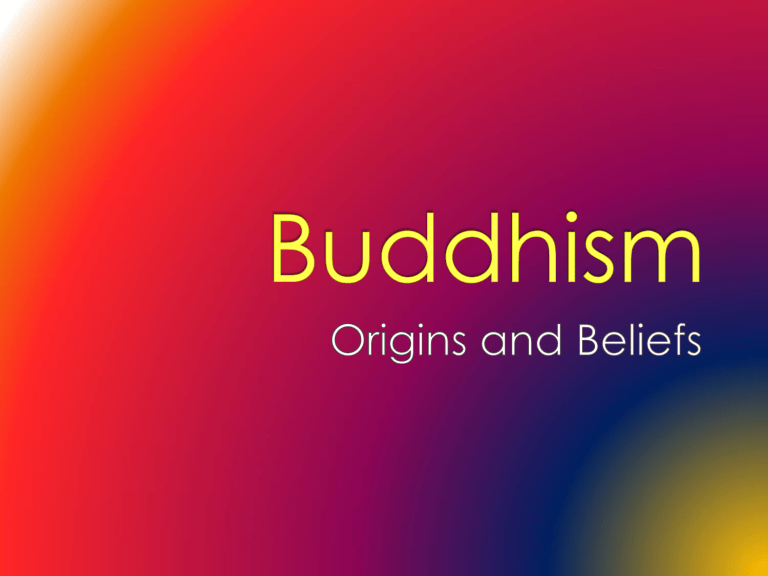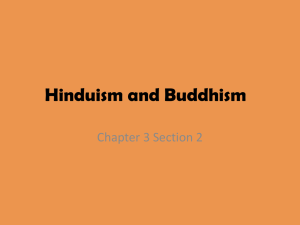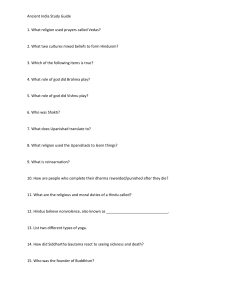Buddhist Wisdom
advertisement

563 BCE The Birth of Siddhartha Gautama 531-486 BCE Teaching Period of the Buddha 200 BCE Beginnings of Mahayana Buddhism 100-538 CE Spread of Buddhism to other countries 750 CE Buddhism spreads to Tibet 1959 CEChinese takeover of Tibet: Dalai Lama flees 1989 CEDalai Lama wins Nobel Peace Prize 1990s CE International interest in Buddhism increases 1992 CE The Falun Gong movement first made public Read the biography of Gautama provided in class and answer the questions attached. Be prepared to discuss these questions as a class. The Life of Buddha… Legendary Birth -Aprox. 563 BCE -later versions include a miraculous birth story Www.blog.tsemtulku.com Was born about 2500 years ago Was son of the king in northern India Had a wonderful and luxurious childhood His father tried to shelter him from suffering. Went to a nearby village and saw the elderly, sick, dead, poor He was horrified, could not enjoy castle life any longer Discovery of Suffering -Old age -Disease -Death -Shramanas In search of the meaning of life, Gautama left home and spent 6 years in the forest › Phase one: learning from monks › Phase two: discovers The Middle Way › Phase three: Raja Yoga and enlightenment* Instead of looking outside he looked inside himself. › › His own past lives Other’s past lives Achieves Nirvana (a state of supreme realization.) Attains knowledge of: -omniscience Becomes the Buddha Begins spreading his teachings *Buddha means the “enlightened/ awakened one” In this third phase, he becomes aware of the Four Noble Truths and the Eightfold Path The Buddha was not a god or a legend. He was a person that went out to seek the truth. He traveled all over finding help from others like him, almost starved to death and slept on beds of thorns. But all he had to do was close his eyes, and look within himself. After achieving Nirvana, he spends the rest of his life travelling and teaching people how to achieve peace and end suffering. India Prior To Buddhism… •Buddhism has its roots in northern India and Hinduism. •It began as a reform movement. •Siddhartha Gautama, the founder of Buddhism, sought a new way of practising religion. India Prior To Buddhism… Hinduism -Established in 1500 BCE Vedas -Caste system Some Teachings of the Upanishads: -Samsara -Karma -Moksha -Yoga Shramanas In addition to the Caste system, what other aspects of Hindu practice and belief does Buddha reject? (refer to your reading) After reading the brief biography of Siddharta Gautama, what connections can be made between him and Jesus in terms of spiritual teachings and actions? Spreading of Buddhism -India - spread by ascetics -disappears 12th century -Asia -spread through trade -West -enters 19th century www.world-religion.org Buddhism becomes popular in the west Many movies are made depicting Buddhism Buddhism began in India Siddhartha was of the Kshatryria caste and was raised with Hindu beliefs practices. He was in line to become a king. Samsara Karma Mediation to bring about clarity. So what new ideas are distinctly Buddhist? After achieving Nirvana, he spends the rest of his life travelling and teaching people how to achieve peace and end suffering. He decides to teach everyone the nature of reality—the dharma for the world. Nirvana is a state of supreme realization and enlightenment. Buddha wanted to spread this knowledge of dharma so others too could achieve Nirvana. Hinduism › Refers primarily to behaviours that are in accord with the right order of things › i.e., caste system Buddhism › Refers to the reality or truth of the world › Buddha’s teachings are dharma Called the Dharmachakra, or Wheel of Dharma about the nature of human existence and what people must do to release themselves from suffering. All things outside of Nirvana have… 1) Annica (impermanence) -Nothing stays the same; everything changes 2) Dukkha (dissatisfaction) -all living beings experience suffering; feelings of happiness do not last forever; dukkha touches all of existencce 3) Anatta (no-self) -no one thing within us can be called the self -no permanent self (no underlying soul) http://www.hinduwebsite.com/buddhis m/anatta-rebirth.asp Rules to control improper behaviour that can lead to suffering. › Ahimsa (non-violence) › No stealing › Abstain from improper sexual conduct › Abstain from false speech › Abstain from taking alcohol and harmful drugs *There are assitional precepts. The ones above are the most common. 1. Suffering (dukkha) and unhappiness are a part of human life. No one can escape sorrow. 2. Suffering comes from our desires for pleasure and material goods (greed and selfishness) 3. People can overcome desire and ignorance and reach nirvana, a state of perfect peace. People can overcome ignorance and desire by following an 4. eightfold path that leads to wisdom, enlightenment, and salvation. Read pages 172173 of the textbook and describe each of part of the Eightfold path Ask yourself? Which parts are you great in and practicing daily? Which parts are you lacking in? •He concluded that The Noble Eightfold Path becomes the Middle Way neither his old life of luxury nor the life of a religious ascetic was the right way to live. •He began to develop a middle way between luxury and asceticism, giving up greed and selfishness as well as harsh denial of pleasure. Centre—Nirvana 8 spokes –8 steps for Buddhist Use all together (Middle Way— Balance) View ( noble truths) Thought (good and pure) Speech (kind and trurthful) Conduct/Action (5 precepts) Livelihood (helpful not harming) Effort (goodwill) Mindfulness (wholesome attention) Concentration (single focus) : •It is seen as non-theistic •They believe that by following the teachings of the Buddha they will find peace •The Buddha found ways to overcome the imperfectness •They meditate •They believe that the Buddha was human Buddhist Theism http://wisdomquarterly.blogspot.com/2011/04/saint-to-visit-losangeles-april-17-19.html • Buddha is often called “devatideva” • This is because he fully understands the deities • He is often prayed to, but not as a god 1) 2) His first five ascetic companions (at the first sermon) became the first monks—known as bhikkhus. 2) He continued to teach for 45 years. During this time he had many disciples learning from him. 3) Within five years an order of monks is established—called the sangha 4) Later nuns also established—called bhikkhuni sangha Buddha dies at age 80 in the year 486 BCE. This is where he is believed to reach complete nirvana (parinirvana) This “nirvana-afterdeath” occurs on a dead body who achieved nirvana in their lifetime The Buddha (teacher) The darma (teaching) Sangha (community of believers) Giving 2) Morality 3) Vigour 4) Meditation 5) Patience 6) wisdom 1) Practised by a Bodhisattva His teachings were not written down during his lifetime; they were written down by his followers 400 years later. Why were the teachings so easily spread for 400 years? What made the teachings of the Buddha easy to follow and practice? Hinduism Buddhism › Caste system › Rejects caste system › Dharma (relates to › Dharma is the reality of caste) › Belief in god › Belief in an eternal soul the world › No theism › Anatta (no self/no soul)








